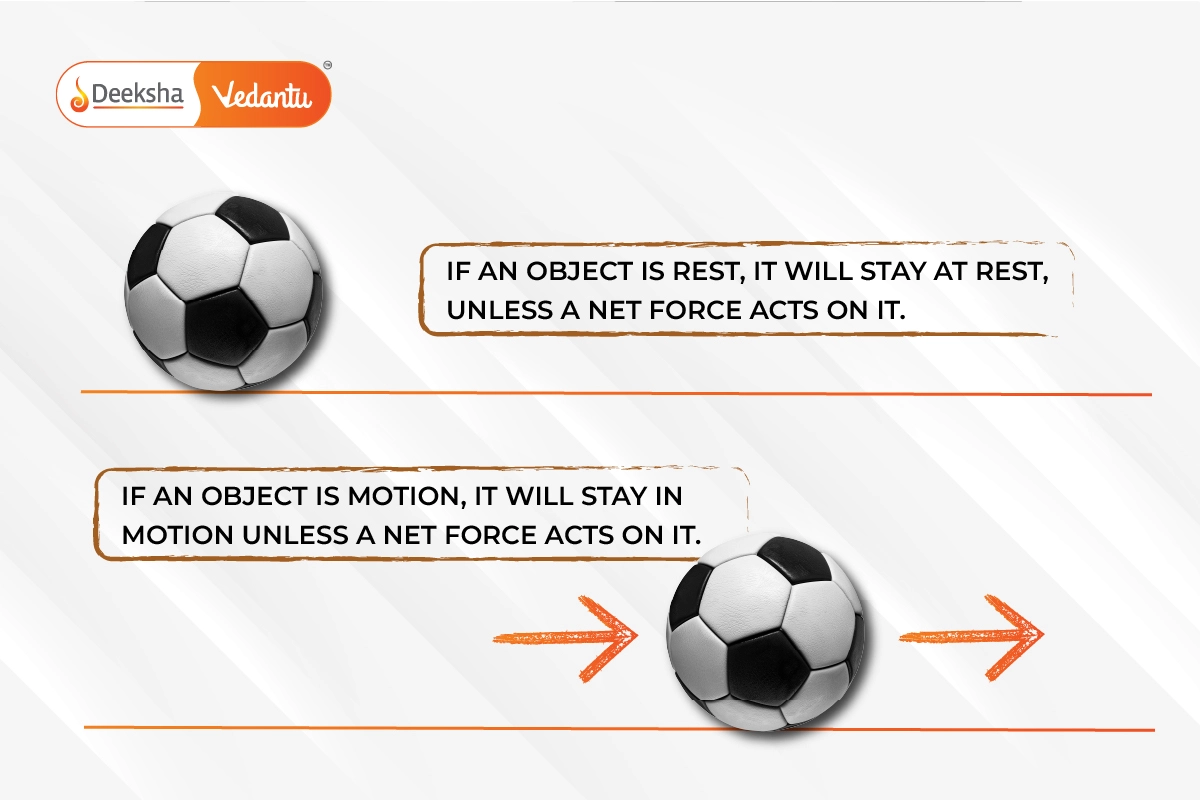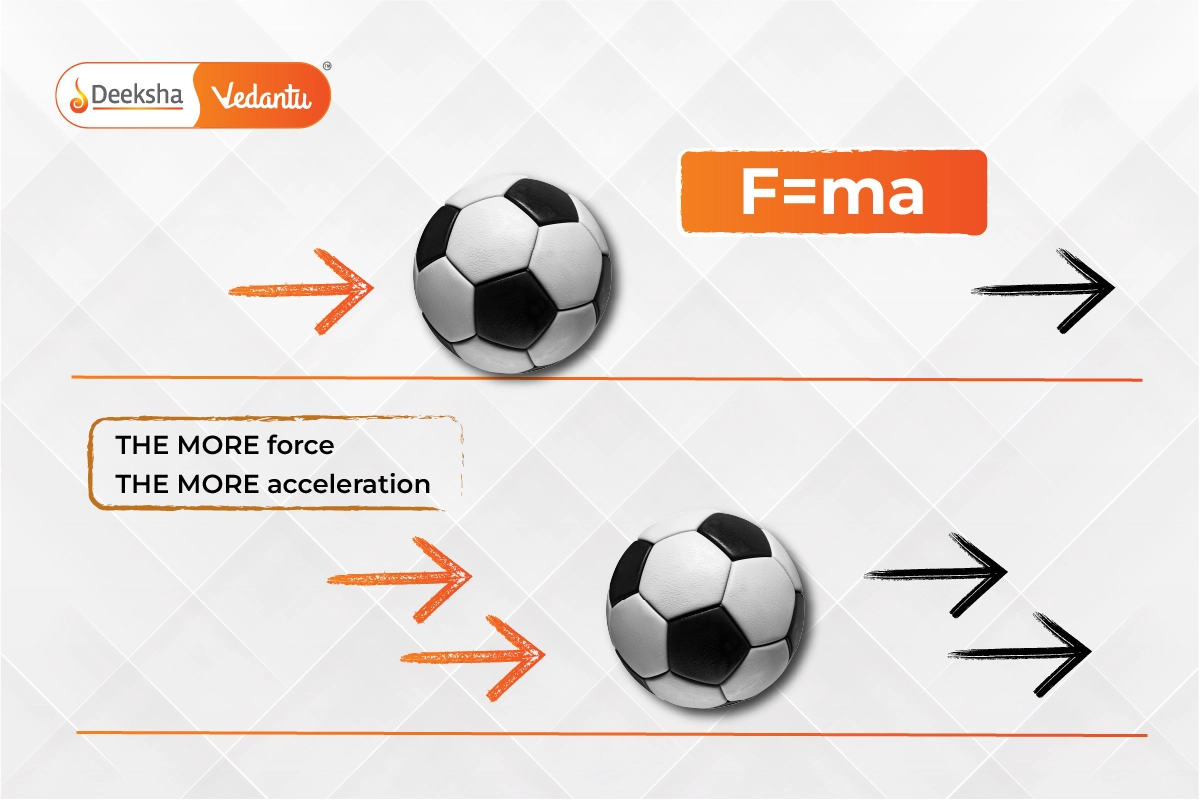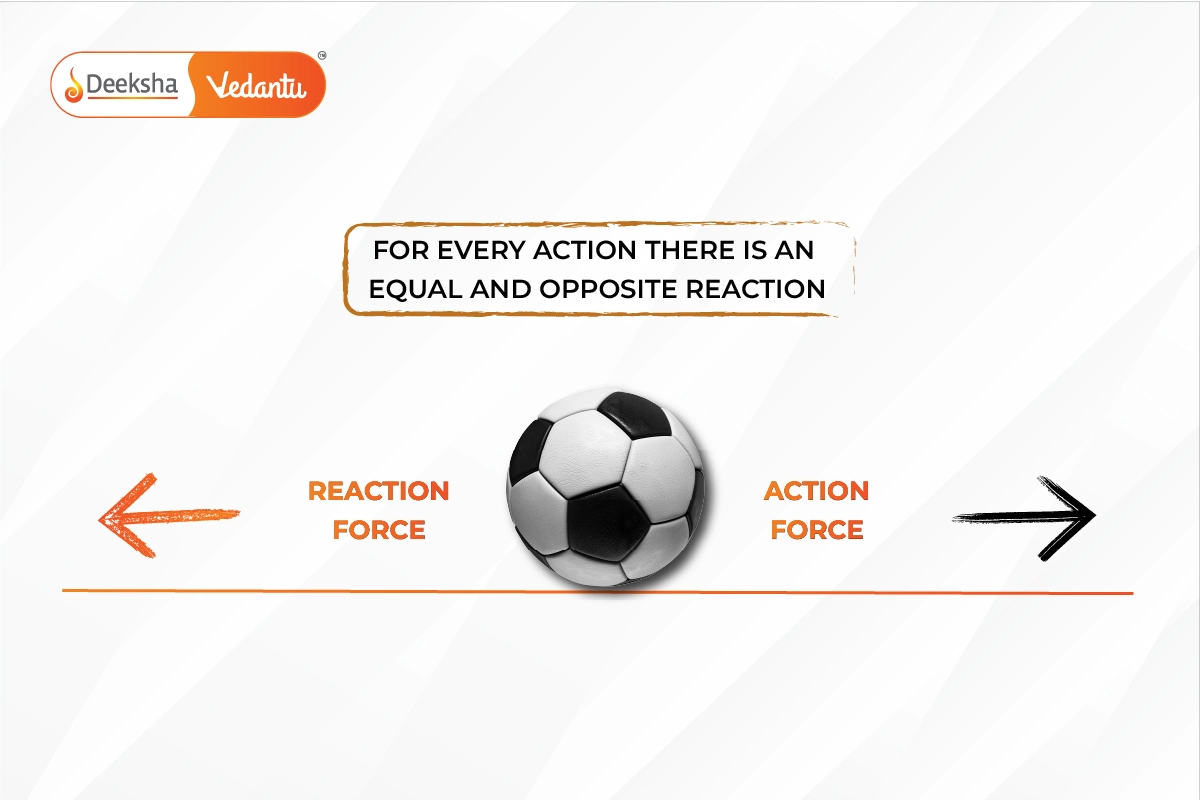Newton’s First Law of Motion
Newton’s First Law of Motion, also known as the Law of Inertia, is a key principle that explains how objects behave when no external forces are acting on them. The term “Law of Inertia” highlights the tendency of objects to resist changes in their motion. This means that objects naturally stay at rest or continue moving uniformly in a straight line unless an external force changes their state.
Inertia refers to the property of objects that makes them resist changes to their motion. Newton’s first law states that an object will remain in its current state, either at rest or moving uniformly, unless acted upon by an external force. This law implies that if no net external force is applied, an object will maintain a constant velocity.

For example:
- If an object is at rest, it will stay at rest.
- If an object is moving, it will keep moving at the same speed and in the same direction.
However, when an external force is applied, the object’s motion will change in accordance with the force’s magnitude and direction. This change could be an increase in speed, a decrease in speed, or a change in direction.
Understanding Newton’s First Law is essential because it lays the groundwork for studying how forces affect motion. By grasping this principle, we gain a better understanding of how objects move on their own and how they respond to external forces, forming a foundation for exploring more complex concepts in physics.
Key Points:
- Inertia: Objects resist changes in their state of motion.
- Constant Motion: Without a net external force, an object remains at rest or moves uniformly.
- Effect of Forces: External forces cause changes in an object’s velocity (speed and direction).
This fundamental law helps us understand the behavior of objects in various situations, both in everyday life and in more advanced scientific contexts.
Newton’s Second Law of Motion
Newton’s Second Law of Motion offers a comprehensive explanation of how objects respond to external forces. This law establishes the connection between the force exerted on an object and the acceleration that results from this force. Essentially, it quantifies the effect of force on an object’s motion.
Statement of the Second Law
According to Newton’s Second Law, the force (F) acting on an object is equal to the product of its mass (m) and the acceleration (a) it experiences. This relationship is expressed mathematically as:
F = m x a
Here:
F represents the force applied to the object.
m denotes the mass of the object.
a indicates the acceleration produced due to the force.

The equation reveals two key insights:
- Direct Proportionality: The acceleration of an object is directly proportional to the net force acting on it. This means that if you increase the force, the acceleration increases proportionally, assuming the mass remains constant.
- Inverse Proportionality: The acceleration is inversely proportional to the mass of the object. For a given force, a more massive object will accelerate less than a lighter one.
By delving into Newton’s Second Law, we gain a quantitative framework for understanding and predicting how objects move under the influence of forces, paving the way for more advanced studies in mechanics and other branches of physics.
Newton’s Third Law of Motion
Newton’s Third Law of Motion introduces the intriguing relationship between interacting forces, encapsulating the principle of action and reaction.
Statement of the Third Law
Newton’s Third Law states: For every action, there is an equal and opposite reaction. This means that when two bodies interact, they exert forces on each other that are equal in magnitude but opposite in direction. Essentially, forces always come in pairs.

Explanation and Example
To illustrate this principle, imagine a book resting on a table:
- The book exerts a downward force on the table due to its weight.
- In response, the table exerts an upward force on the book, equal in magnitude to the weight of the book but opposite in direction.
This interaction occurs because the book slightly deforms the table’s surface, causing the table to push back on the book, similar to how a compressed spring releases its energy.
Implications
- Force Pairs: In every interaction, force pairs are present. If you push against a wall, the wall pushes back with an equal and opposite force. This concept is evident in various scenarios, from walking (where your feet push against the ground and the ground pushes back) to the propulsion of rockets (where exhaust gases push outwards, and the rocket is pushed forward).
- Conservation of Momentum: Newton’s Third Law also plays a crucial role in the conservation of momentum. Momentum is a measure of an object’s motion and is the product of its mass and velocity. According to this law, in an isolated system (where no external forces are acting), the total momentum remains constant. This means the total momentum before and after an interaction is the same, regardless of the forces involved.
For instance, when two ice skaters push off from each other, they move in opposite directions. The momentum they gain is equal and opposite, ensuring the total momentum of the system remains unchanged.
Laws of Motion Numerical
- A hockey puck is sliding on ice with negligible friction. If no external force acts on the puck, what will happen to its motion?
Solution:
According to Newton’s First Law of Motion (Law of Inertia), an object in motion will remain in motion with a constant velocity unless acted upon by an external force. Since the problem states that friction is negligible and no external force is acting on the puck, the puck will continue to slide with a constant velocity.
- A 5 kg object is subjected to a net force of 20 N. What is the acceleration of the object?
Solution:
Using Newton’s Second Law of Motion:
F = m x a
Where
F is the force,
m is the mass, and
a is the acceleration.
Rearranging for acceleration, we get:
a = F / m
Substitute the given values:
a = 20N / 5kg
a = 4 m / s^2
So, the acceleration of the object is 4 m / s^2
- A swimmer pushes against the wall of a pool with a force of 150 N. What force does the wall exert on the swimmer?
Solution:
According to Newton’s Third Law of Motion, for every action, there is an equal and opposite reaction. Therefore, if the swimmer exerts a force of 150 N on the wall, the wall exerts an equal and opposite force of 150 N on the swimmer.
FAQs
Newton’s First Law is called the Law of Inertia because it describes the inherent property of objects to resist changes in their motion. This concept of inertia is central to understanding why objects remain in their current state of rest or motion unless acted upon by an external force.
According to Newton’s Second Law, the acceleration of an object is inversely proportional to its mass. This means that heavier objects (with more mass) will accelerate less than lighter objects when the same amount of force is applied.
Friction is an external force that acts opposite to the direction of motion, causing objects to slow down and eventually stop. Without friction, an object in motion would continue moving indefinitely at a constant speed and direction.
A common example of Newton’s Third Law is the interaction between a swimmer and the water. When a swimmer pushes against the water with their hands, the water pushes back with an equal and opposite force, propelling the swimmer forward.
In the equation F = m x a, the proportionality constant is 1 when using SI units. This simplifies the relationship to a direct proportionality between force, mass, and acceleration, making it easier to calculate one if the other two are known.
Inertia is the property of an object to resist changes in its state of motion. It is the tendency of an object to remain at rest if it is at rest, or to continue moving in a straight line at a constant speed if it is in motion.
Related Topics
- Full Wave Rectifier
- Human Eye – Structure and Functioning
- Noise Pollution
- Electric Current And Circuit
- Magnetic Effects Of Electric Current
- List of Physics Scientists and Their Inventions
- Magnetic Field And Field Lines
- Mirrors
- Projectile Motion
- Spherical Mirrors
- Work, Energy and Power
- Fleming’s Left-Hand Rule and Right-Hand Rule
- Refraction Of Light
- Reflection Of Light
- Magnetic Field Due To A Current – Carrying Conductor







Get Social